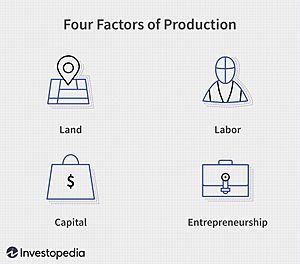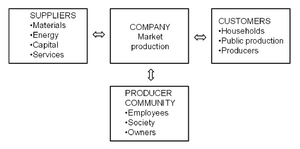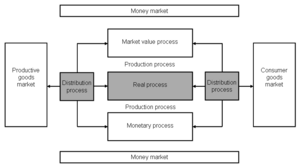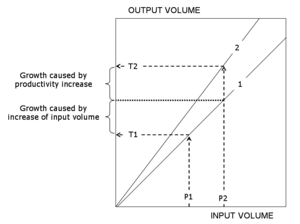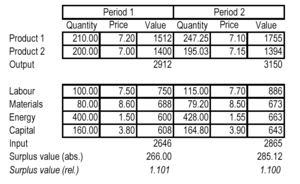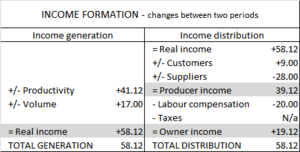Economic production facts for kids
Production is all about making things! It's the way we combine different ingredients and ideas to create something new. These ingredients can be physical, like metal, wood, or plastic, or they can be ideas, like plans or special knowledge.
The goal of production is to make products or services that people want and find useful. When we make things that people value, it helps improve everyone's well-being. The part of economics that studies how things are made is called production theory.
The things we make are a direct result of using our basic ingredients wisely. These basic ingredients are often called factors of production. The three main ones are:
- Land: This includes all natural resources, like minerals, water, and the land itself.
- Labour: This is the work done by people.
- Capital: This refers to tools, machines, buildings, and money used in production.
Sometimes, people also include entrepreneurship (the skill of starting and running a business) and technology as important factors. Many different inputs are usually needed to create a product. We use something called a production function to understand how these inputs relate to the amount of output we get.
When things are produced, it helps create economic well-being. This means all the activities that help satisfy what people want and need! We can measure how well needs are met to see how good economic well-being is. Two main things help increase economic well-being:
- Making products and services better quality for their price.
- Increasing incomes from growing and more efficient production, which helps increase a country's GDP.
The most common ways things are produced are:
- Market production: When businesses make things to sell for a profit.
- Public production: When the government makes things or provides services (like schools or roads).
- Household production: When people make things for themselves or their families (like cooking a meal at home).
Understanding these three types of production helps us see where economic well-being comes from. All of them create things that have value and help people.
When products get better or cheaper, people get more for their money. This makes customers happier and helps businesses compete. For businesses, improving quality or lowering prices often means they need to sell more to make up for it.
Economic well-being also grows when incomes increase from market production. Market production is special because it's the only type that creates and shares income with people. Public production and household production often rely on money made from market production. So, market production is super important because it both makes goods and services and creates income!
Contents
What Makes Production Successful?
Businesses usually aim to make the most profit possible. Profit is the money left over after you subtract the costs of making something from the money you earn selling it. Several key things affect how well production works:
Efficiency
Efficiency is about doing things in the best way possible to get the most out of what you put in. If a factory could make 100 toys with its materials and workers but only makes 60, its efficiency is 60%. Being efficient means using your inputs (like materials and time) to get the maximum possible output.
Technology
New technology is a huge deal for production! Think about how the Industrial Revolution changed everything. New machines and methods help us make things faster, better, and often cheaper. That's why it's important to keep developing and using new technologies.
How People Behave and What They Buy
Producers usually want to make as much profit as they can. How much people buy (their consumption) directly affects how much needs to be produced. This is like the idea of supply and demand. If production goes down more than people stop buying, it means less productivity. But if production goes up more than consumption, it means increased productivity!
Pricing
In a market, the prices of the materials you buy and the products you sell are often set by outside factors. If the price of making something is too high, it might not be worth producing at all. Pricing is closely linked to how much people buy, which then affects how much is produced.
How Production Creates Well-Being
There are two main activities in an economy: making things (production) and using things (consumption). And there are two main types of people: producers (who make things) and consumers (who use them). Everyone's well-being comes from efficient production and how producers and consumers interact.
Consumers play two roles that create well-being:
- They are customers who buy products. Their well-being comes from getting useful things.
- They are suppliers who provide things like labor or materials to producers. Their well-being comes from the income they get for their contributions.
Who Benefits from Production?
The people, groups, or organizations interested in a company are called its stakeholders. Economic well-being comes from efficient production and is shared among these stakeholders. We can group them into three main categories:
- Customers: These are the people or other businesses who buy the products. Because companies compete, products often get better or cheaper over time. This means customers get more for less! For families, it means they can satisfy more needs without spending more money.
- Suppliers: These are the businesses that provide materials, energy, tools, or services to the company. Changes in the prices or quality of what suppliers provide affect both the company and the suppliers.
- Producers: This group includes the workers, the community, and the owners of the company. They earn income as production grows and becomes more efficient. When a company does well, it can pay better salaries, more taxes, and higher profits. This growth in production and efficiency creates more income for everyone involved.
The well-being from products comes from their price and quality. As markets develop and competition increases, products usually get better and cheaper. This helps customers get more satisfaction for less money.
The producer community (workers, society, and owners) earns income for their contributions to production. When production grows and becomes more efficient, incomes tend to increase. This means more money for salaries, taxes, and profits.
Main Steps in a Company's Production
A company's production can be seen as several main steps, each with its own goals and ways of being measured:
- Real process: This is where the actual product is made from the inputs. It's about combining different materials and efforts to create goods or services.
- Income distribution process: This is about how the money earned from production is shared among everyone involved (workers, owners, suppliers, etc.).
- Production process: This combines the real process and the income distribution process.
- Monetary process: This is about how the business is financed and handles its money.
- Market value process: This is how investors decide what the company is worth in the market.
The "real process" is where the actual product is created. It's like a recipe where ingredients (inputs) are mixed to make a dish (output). The value created in this process is then shared between the customer and the producer.
The "income distribution process" is about how changes in prices of products or inputs affect how income is shared. For example, if a company becomes more efficient, it might lower prices for customers or pay higher wages to staff.
The "production process" includes both the making of the product and the sharing of the income. For owners, success is measured by how profitable the company is.
How Production Grows and Performs
Economic growth is often seen as an increase in what a production process makes. We usually talk about it as a percentage of how much the "real output" has grown. "Real output" is the true value of products made. When we subtract the "real input" (what went into making it), we get the "real income." This real income comes from the "real process" of production.
A production function is a way to show how the inputs used in production relate to the amount of output achieved. It helps us understand how income is generated. It has two parts:
- A change in the amount of inputs used.
- A change in how productive the process is.
Imagine you have a lemonade stand. If you use more lemons and sugar (more inputs), you'll make more lemonade. That's growth from increased inputs. But if you find a faster way to squeeze lemons and mix the drink, you'll make more lemonade with the same amount of lemons and sugar. That's growth from increased productivity!
Productivity growth is often a sign of innovation – creating new products, better ways of doing things, or new business ideas. This means you get more output for the same amount of input. Income can also grow just by doing more of what you already do well, even without new innovations.
When we look at many production processes together, we often talk about "value-added." This means the extra value a process creates. The most famous measure of value-added for a whole country is the GDP, which is used to track how much a nation's economy grows.
Measuring Income: Total vs. Average
We can measure how well production performs in two ways:
- Average income: This is like asking, "How much output do we get for each unit of input?" We calculate it as Real output / Real input.
- Absolute (total) income: This is the actual amount of new economic value created. We calculate it as Real income = Real output – Real input.
The growth of "real income" is the increase in economic value that can be shared among everyone involved in production. To truly maximize how well production performs, we should focus on maximizing this "real income."
Sometimes, you might hear about "jobless growth." This happens when the economy grows because of increased productivity, but it doesn't create new jobs. For example, a company might use new machines to make more products with fewer workers. While the company's output goes up, fewer people get jobs. This shows why just looking at "average productivity" can be tricky; sometimes, overall well-being increases even if average productivity seems to go down, especially if more people get jobs, even if those jobs aren't super high-tech.
The Production Function Explained
In the short term, a production function assumes that at least one of your inputs (like the size of your factory) is fixed. It shows how many inputs a business uses and how much output it gets.
There are three ways to measure production and productivity:
- Total output: This is simply the total amount of product made. It's easy to measure for things like cars, but harder for services like teaching or consulting.
- Average output: This measures how much output is produced per worker or per unit of capital (like per machine).
- Marginal product: This is the extra output you get by adding just one more worker or one more machine.
There's a concept called the law of diminishing marginal returns. It means that if you keep adding more of one input (like workers) while keeping other inputs fixed (like the size of the factory), at some point, the extra output you get from each new worker will start to decrease.
The time it takes for all factors of production to become flexible (meaning you can change everything, like building a new factory) varies a lot. For a nuclear power plant, it can take many years!
How We Model Production
A production model is a way to describe the production process using numbers, based on the prices and amounts of inputs and outputs. We can use mathematical formulas (often in big-picture economics) or simpler arithmetic models (often used by businesses).
We'll focus on arithmetic models because they are easier to understand and apply in real life, like in business accounting. They help us see the production function as part of the whole production process.
Two common models are the production income model and the production analysis model.
Production Income Model
A key way to measure success in production is by its ability to create surplus value. This is the difference between the money earned from selling products and the total costs of making them (including the cost of the owner's investment). If the surplus value is positive, it means the company made more than expected!
To measure this accurately, it's important that the data used for inputs and outputs is very clear and specific. For example, you shouldn't just group "materials" together; you should track each type of material separately to get a precise measurement.
Understanding the Numbers
When we calculate how production is doing, we often use the idea of ceteris paribus, which means "all other things being equal." This helps us look at one change at a time.
First, we figure out how changes in prices affect profitability (the income distribution process). Then, we look at how changes in the actual production (the real process) affect profitability.
The results are easy to understand. For example, if the "real income" increased, we can see how much of that increase came from being more productive (doing things better) and how much came from simply making more products (volume growth). This total increase in real income is then shared among all the stakeholders – customers, suppliers, and owners.
This leads to an important idea: the income created by production is always balanced with how that income is shared. The changes in real income and how it's distributed are always equal in terms of economic value.
By looking at how productivity and production volume change, we can even tell if production is in a phase of "increasing returns" (where adding more inputs gives you even more output) or "diminishing returns" (where adding more inputs gives you less and less extra output).
What Are the Goals of Production?
To better understand how production performs, we can think about different goals, depending on who is interested. The most common goal is profit maximization, which means making the most money for the owners.
Setting Goals for Production
Here are some goals that can be set for production:
- Maximizing real income: Making the most overall economic value.
- Maximizing producer income: Making the most income for the workers, society, and owners.
- Maximizing owner income: Making the most profit for the owners.
These goals can be shown in a simple calculation that looks a bit like an income statement. It shows how income is generated and then how it's distributed. The total income generated and the total income distributed are always equal.
Another Way to Look at It
We can also figure out the change in "real income" by looking at how prices change for products and inputs. This is called the "dual approach" because it looks at things from the perspective of prices instead of quantities. It means that you get the same result whether you calculate the change in total income generated or the change in total income distributed.
See also
 In Spanish: Producción (economía) para niños
In Spanish: Producción (economía) para niños


